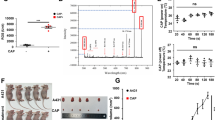Abstract
Chronic UVA irradiation has been reported to induce photoaging and photocarcinogenesis. UVA is a potent inducer of reactive oxygen species (ROS), which can induce various biological processes, including apoptosis. Polypeptide from Chlamys farreri (PCF) is a novel marine active material isolated from the gonochoric Chinese scallop C. farreri. In our previous studies, PCF was found to be an effective antioxidant inhibiting UVA-induced ROS production and a potential inhibitory agent for UVA-induced apoptosis in the human keratinocyte cell line HaCaT. The intracellular mechanisms of how PCF protects HaCaT cells from UVA-induced apoptosis are not understood. Thus, we here investigate the effect of PCF on UVA-induced intracellular signaling of apoptosis. Pretreatment with the ROS scavenger N-acetylcysteine (NAC), the p38 MAPK inhibitor SB203580 or the caspase-3 inhibitor Ac-DEVD-CHO was found to effectively prevent UVA-induced apoptosis, indicating that ROS, p38 MAPK and caspase-3 play important roles in apoptosis. H2O2-induced apoptosis was attenuated by PCF, suggesting that PCF plays its anti-apoptotic role through its antioxidant activity. In addition, PCF treatment inhibited UVA-induced p38 MAPK activation and caspase-3 activation, as assayed by Western blot analysis and flow cytometry, respectively. Our results suggest that PCF attenuates UVA-induced apoptosis through a reduction of ROS generation and diminished p38 MAPK and caspase-3 activation.




Similar content being viewed by others
References
Offord EA, Gautier JC, Avanti O, Scaletta C, Runge F, Kramer K, Applegate LA (2002) Photoprotective potential of lycopene, beta-carotene, vitamin E, vitamin C and carnosic acid in UVA-irradiated human skin fibroblasts. Free Radic Biol Med 32:1293–1303
de Gruijl FR (2000) Photocarcinogenesis: UVA vs. UVB. Methods Enzymol 319:359–366
Matsui MS, DeLeo VA (1991) Longwave ultraviolet radiation and promotion of skin cancer. Cancer Cells 3:8–12
de Laat A, van der Leun JC, de Gruijl FR (1997) Carcinogenesis induced by UVA (365-nm) radiation: the dose–time dependence of tumor formation in hairless mice. Carcinogenesis 18:1013–1020
Sterenborg HJ, van der Leun JC (1990) Tumorigenesis by a long wavelength UV-A source. Photochem Photobiol 51:325–330
Ichihashi M, Ueda M, Budiyanto A, Bito T, Oka M, Fukunaga M, Tsuru K, Horikawa T (2003) UV-induced skin damage. Toxicology 189:21–39
Buttke TM, Sandstrom PA (1994) Oxidative stress as a mediator of apoptosis. Immunol Today 15:7–10
Obata T, Brown GE, Yaffe MB (2000) MAP kinase pathways activated by stress: the p38 MAPK pathway. Crit Care Med 28:N67–N77
Shimizu H, Banno Y, Sumi N, Naganawa T, Kitajima Y, Nozawa Y (1999) Activation of p38 mitogen-activated protein kinase and caspases in UVB-induced apoptosis of human keratinocyte HaCaT cells. J Invest Dermatol 112:769–774
Assefa Z, Vantieghem A, Garmyn M, Declercq W, Vandenabeele P, Vandenheede JR, Bouillon R, Merlevede W, Agostinis P (2000) p38 mitogen-activated protein kinase regulates a novel, caspase-independent pathway for the mitochondrial cytochrome c release in ultraviolet B radiation-induced apoptosis. J Biol Chem 275:21416–21421
Hildesheim J, Awwad RT, Fornace AJ Jr (2004) p38 Mitogen-activated protein kinase inhibitor protects the epidermis against the acute damaging effects of ultraviolet irradiation by blocking apoptosis and inflammatory responses. J Invest Dermatol 122:497–502
Patel T, Gores GJ, Kaufmann SH (1996) The role of proteases during apoptosis. FASEB J 10:587–597
Kimura C, Zhao QL, Kondo T, Amatsu M, Fujiwara Y (1998) Mechanism of UV-induced apoptosis in human leukemia cells: roles of Ca2+/Mg2+-dependent endonuclease, caspase-3, and stress-activated protein kinases. Exp Cell Res 239:411–422
Dou M, Han Y, Han Z, Chen X, Wang Y, Tan J, Wang C, Hou Y (2004) Inhibitory effect of polypeptide from Chlamys farreri on UVA induced apoptosis in human keratinocytes. Invest New Drugs 22:391–398
Khodarev NN, Sokolova IA, Vaughan AT (1998) Mechanisms of induction of apoptotic DNA fragmentation. Int J Radiat Biol 73:455–467
Chung JH, Han JH, Hwang EJ, Seo JY, Cho KH, Kim KH, Youn JI, Eun HC (2003) Dual mechanisms of green tea extract (EGCG)-induced cell survival in human epidermal keratinocytes. FASEB J 10:1913–1915
Tarozzi A, Marchesi A, Hrelia S, Angeloni C, Andrisano V, Fiori J, Cantelli-Forti G, Hrelia P (2005) Protective effects of cyanidin-3-O-beta-glucopyranoside against UVA-induced oxidative stress in human keratinocytes. Photochem Photobiol 81:623–629
Yao RY, Wang CB (2002) Protective effects of Polypeptide from Chlamys farreri on Hela cells damaged by ultraviolet A. Acta Pharmacol Sin 23:1018–1022
Han YT, Han ZW, Yu GY, Wang YJ, Cui RY, Wang CB (2004) Inhibitory effect of polypeptide from Chlamys farreri on ultraviolet A induced oxidative damage on human skin fibroblasts in vitro. Pharmacol Res 49:265–274
Lu SC (2000) Regulation of glutathione synthesis. Curr Topics Cell Reg 36:95–116
He YY, Hader DP (2002) UV-B-induced formation of reactive oxygen species and oxidative damage of the cyanobacterium Anabaena sp.: protective effects of ascorbic acid and N-acetyl-l-cysteine. J Photochem Photobiol B 66:115–124
Slyshenkov VS, Piwocka K, Sikora E, Wojtczak L (2001) Pantothenic acid protects jurkat cells against ultraviolet light-induced apoptosis. Free Radic Biol Med 30:1303–1310
Peus D, Vasa RA, Beyerle A, Meves A, Krautmacher C, Pittelkow MR (1999) UVB activates ERK1/2 and p38 signaling pathways via reactive oxygen species in cultured keratinocytes. J Invest Dermatol 112:751–756
Kabuyama Y, Homma MK, Sekimata M, Homma Y (2001) Wavelength-specific activation of MAP kinase family proteins by monochromatic UV irradiation. Photochem Photobiol 73:147–152
Ding M, Li J, Leonard SS, Shi X, Costa M, Castranova V, Vallyathan V, Huang C (2002) Differential role of hydrogen peroxide in UV-induced signal transduction. Mol Cell Biochem 234–235:81–90
Bachelor MA, Bowden GT (2004) Ultraviolet A-induced modulation of bcl-xl by p38 MAPK in human keratinocytes: post-transctiotional regulation through the 3′ untranslated region. J Biol Chem 279:42658–42668
Tada-Oikawa S, Oikawa S, Kawanishi S (1998) Role of ultraviolet A-induced oxidative DNA damage in apoptosis via loss of mitochondrial membrane potential and caspase-3 activation. Biochem Biophys Res Commun 247:693–696
Acknowledgments
The work was supported by the National Science Natural Foundation of China (No. 30471458) and Science Foundation of Shandong province (No. Y2003c02).
Author information
Authors and Affiliations
Corresponding author
Rights and permissions
About this article
Cite this article
Li, JL., Liu, N., Chen, XH. et al. Inhibition of UVA-induced apoptotic signaling pathway by polypeptide from Chlamys farreri in human HaCaT keratinocytes. Radiat Environ Biophys 46, 263–268 (2007). https://doi.org/10.1007/s00411-007-0112-5
Received:
Accepted:
Published:
Issue Date:
DOI: https://doi.org/10.1007/s00411-007-0112-5




